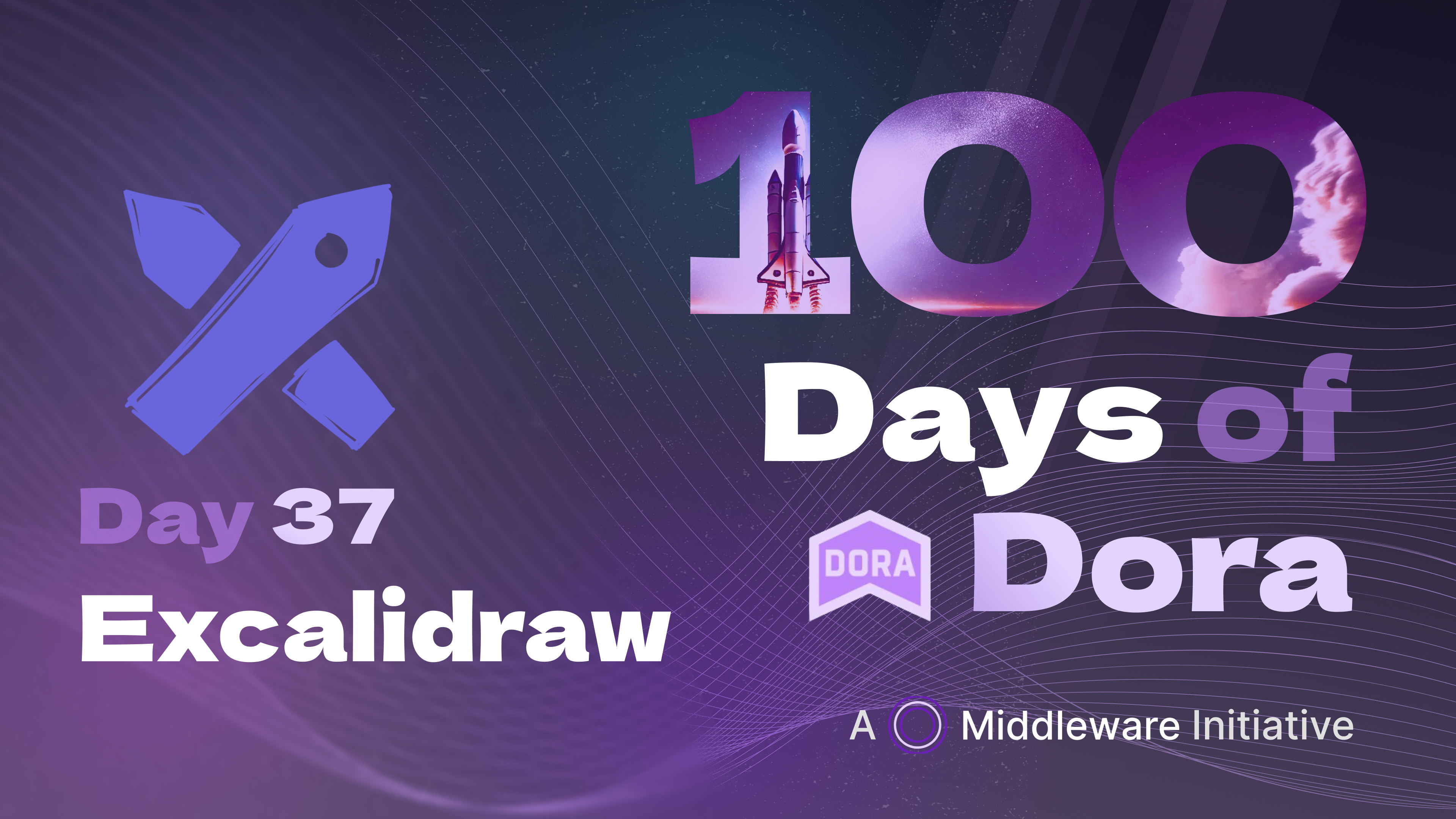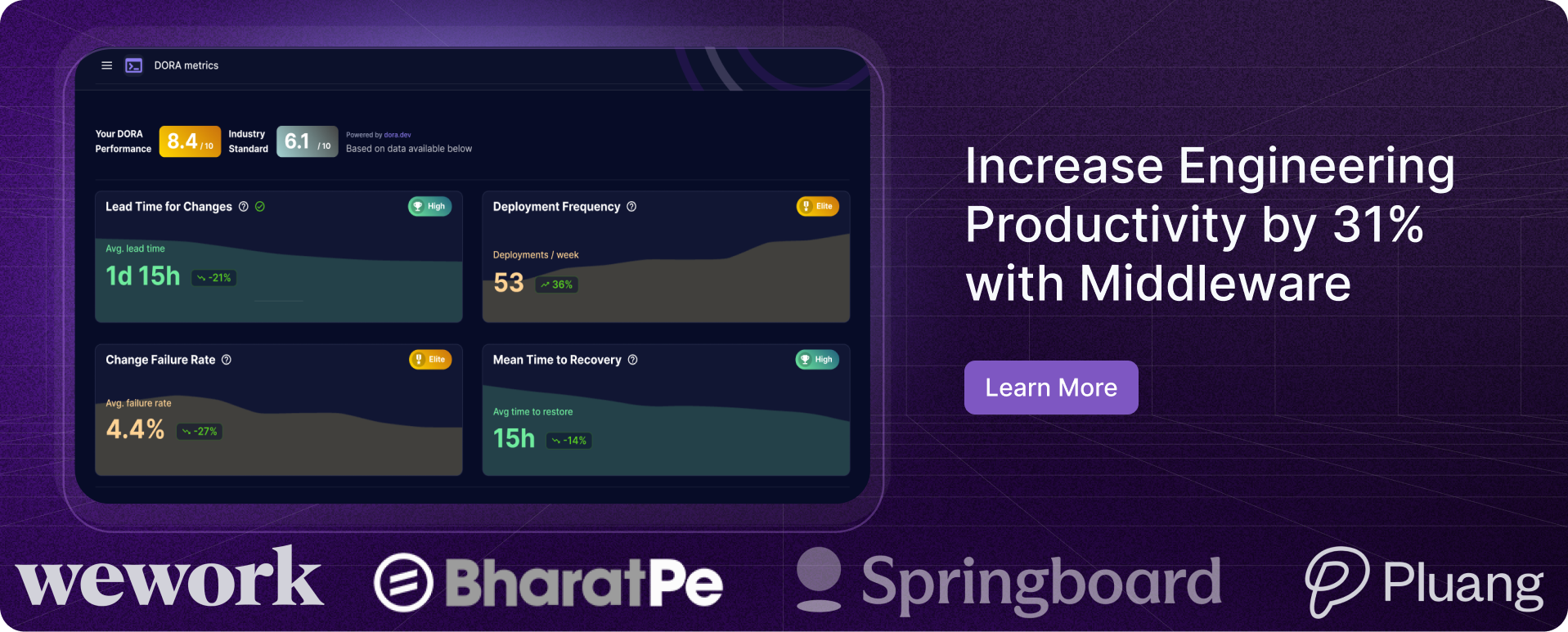Excalidraw Dora Metrics: A David Among Goliaths – Terrific Cycle Time, Snail-Pace PR Merges
 Rajni Rethesh
Rajni Rethesh
How cool it would be if you had a whiteboard that lives in your browser—always ready for quick sketches, brainstorming sessions, and project diagrams. That’s Excalidraw for you! It’s a collaborative, open-source digital canvas where your ideas can run wild, whether you’re doodling wireframes, mapping workflows, or just jotting down chaotic thoughts during a meeting.
It’s got that casual, hand-drawn vibe, so your diagrams don’t feel stiff or over-engineered (no offense, flowcharts!). But don’t let its playful look fool you—Excalidraw is packed with productivity. It supports real-time collaboration, lets you export your visuals with ease, and integrates with popular tools, making it perfect for both individual thinkers and power teams alike.
We dove into Excalidraw’s repository to see how their engineering pipeline is holding up, using Middleware OSS to track their Dora metrics.
Our goal?
To find out what they’re doing right, how fast their PRs are merging, and their cycle time. Spoiler alert: we uncovered some fascinating insights!
Oh, and in case you need a quick refresher—Dora metrics are key indicators of software delivery efficiency, measuring deployment frequency, lead time for changes, mean time to recovery, and change failure rate. Curious for more? Read up on Dora metrics!
Excalidraw’s Performance Review: Metrics, Wins, and Opportunities for Growth
Excalidraw isn’t just a collaborative whiteboard tool—it’s also a project with an efficient engineering pipeline. But like any open-source effort, it has its strengths and areas where tweaks can unleash even more potential. After analyzing their Dora metrics for July, August, and September 2024, here’s a candid, numbers-backed take on what’s working and what could work even better.
Where Excalidraw Excels
1. Merge Times That Impress
With average merge times of 1.55, 2.26, and 2.35 hours over the last three months, Excalidraw’s merge speed is excellent.
It’s clear their CI/CD setup is on point, with smooth, automated workflows ensuring code is ready to deploy almost instantly.
2. Cycle Time? No Sweat!
Excalidraw maintains average cycle times of 15.95, 30.45, and 28.92 hours—solid numbers well within industry benchmarks set by the 2023 State of DevOps Report.
Even August's peak cycle time of 30.45 hours isn't alarming. These figures suggest they’ve got a good rhythm for completing work from start to finish, whether it involves coding, building, or testing.
Recommendation: They could further optimize by automating reviews or pre-commit checks. But frankly, they’re already in a good spot. Staying proactive will ensure cycle times don’t creep up during busier months.
3. Balanced Workload = Healthy Project
Excalidraw maintains a diverse mix of tasks—features (35%), bug fixes (30%), refactoring (20%), and documentation (15%). This balance ensures continuous improvement while preventing technical debt.
They aren't just throwing features into the wild—they’re maintaining, refining, and documenting, which is crucial for a sustainable project.
Notable Wins:
Self-hosting Google fonts by Mrazator
Flip arrowheads feature by dwelle
Support for classDef styling in flowcharts by ad1992
The variety of tasks points to a thoughtful and well-planned approach, keeping the project both modern and bug-free.
4. Fast Responses Keep Contributors Happy
While their first response time averages around 24 hours, it dipped to an impressive 11.45 hours in July. Quick responses like these make contributors feel heard and valued, which is essential in open-source communities.
Also read: MuseScore Dora Metrics: Impressive Deployments, but Rework Could Use a Midas Touch
Slow PR Merges: A Growing Concern for Excalidraw's Development Efficiency
One area where Excalidraw could improve is the number of merged PRs, which fluctuated between 20, 38, and 26 over the last three months.
These figures are significantly below the benchmark set by the 2023 State of DevOps report, indicating that they may be facing challenges in maintaining a steady flow of contributions.
While the occasional spike in August shows potential, the overall numbers hint at periods of slowed contribution flow.
With only 299 contributors, this variation might reflect resource constraints or bottlenecks in review processes.
To enhance consistency, they could leverage their strengths—like efficient merge times and a diverse task mix—by streamlining PR management, encouraging more active participation, or adopting lightweight automation tools to speed up code reviews and merges.
Also read: Puppeteer’s PR Parade: Pulling the Right Strings for 98 Merges and a Dash of Dependency Magic!
Boosting Merged PR Counts: Strategic Recommendations for Excalidraw
To address the concerning trend of low merged pull requests (PRs) within the Excalidraw project—averaging only 26 PRs over the last three months—it's essential to harness the community's existing strengths and implement targeted strategies.
Here are some tailored suggestions from their playbook to enhance the PR merge count:
Leverage Community Expertise: With a dedicated community of 299 contributors, tapping into their unique skills can expedite the merging process. Assign mentors or seasoned contributors to guide newer members through the PR process, enhancing the quality of submissions and reducing review time.
Encourage Feature Collaboration: The project's strength lies in its varied task distribution, including features, fixes, refactoring, and documentation. Encouraging contributors to collaborate on features can lead to more substantial, integrated PRs. Organizing thematic sprints focused on particular features can create a sense of urgency and camaraderie, driving up PR submissions.
Implement a PR Buddy System: Establishing a PR buddy system where contributors pair up to review each other's code can create a sense of ownership and accountability. This peer review process not only accelerates feedback but also fosters community bonds, enhancing the overall workflow.
Showcase Quick Wins: Highlighting and celebrating quick PR wins can motivate contributors. By showcasing merged PRs that have made significant impacts—such as the recently added self-hosting of Google fonts or the flip arrowheads feature—Excalidraw can inspire others to contribute, driving up merge counts.
Automate Routine Reviews: Excalidraw’s existing CI/CD processes can be optimized further by automating the review of routine changes. Implementing bots to check for common issues can free up reviewers to focus on more complex, impactful changes.
Define Clear Contribution Paths: Providing clear guidelines on how to contribute and what types of PRs are most valuable can streamline the submission process. By aligning contributions with the project’s immediate goals, contributors can focus their efforts on areas that are more likely to be merged quickly.
Also read: PyTorch Repository Dora Metrics: Faster Lead Time, Sluggish First Response Time
Excalidraw Dora Metrics: A David Among Goliaths – Excelling in Cycle Time, Snail-Pace PR Merges
With just 299 members, Excalidraw exemplifies what a passionate, tight-knit community can accomplish. Managing a diverse array of tasks with such a lean team is no easy feat, and their ability to deliver polished features alongside bug fixes reflects the dedication of their contributors. However, smaller communities often grapple with challenges, particularly regarding merged PRs. The lower count of merged PRs indicates a potential bottleneck that can hinder progress.
To tackle this issue, fostering more asynchronous participation and grooming junior contributors into review roles could significantly ease the burden on maintainers. This approach would not only improve the speed of merging PRs but also cultivate a culture of continuous learning and engagement, ensuring contributors remain invested for the long haul. By leveraging their strengths, Excalidraw can turn this challenge into an opportunity for growth and innovation.
If you are also grappling through engineering dilemmas, then write to us at productivity@middlewarehq.com and we would be happy to help you provide actionable insights into your workflow or you can also try tracking your Dora metrics yourself using Middleware Open Source that too for free!
Further Resources
Subscribe to my newsletter
Read articles from Rajni Rethesh directly inside your inbox. Subscribe to the newsletter, and don't miss out.
Written by

Rajni Rethesh
Rajni Rethesh
I'm a senior technical content writer with a knack for writing just about anything, but right now, I'm all about technical writing. I've been cranking out IT articles for the past decade, so I know my stuff. When I'm not geeking out over tech, you can catch me turning everyday folks into fictional characters or getting lost in a good book in my little fantasy bubble.
